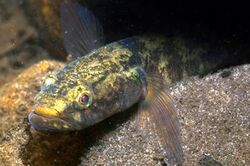Biology:Philypnodon grandiceps
| Philypnodon grandiceps | |
|---|---|

| |
| A Flathead Gudgeon, Philypnodon grandiceps, at Halls Gap, Grampians, Victoria | |
| Scientific classification | |
| Domain: | Eukaryota |
| Kingdom: | Animalia |
| Phylum: | Chordata |
| Class: | Actinopterygii |
| Order: | Gobiiformes |
| Family: | Eleotridae |
| Genus: | Philypnodon |
| Species: | P. grandiceps
|
| Binomial name | |
| Philypnodon grandiceps | |
| Synonyms | |
|
Eleotris grandiceps Krefft, 1864 | |
The flathead gudgeon (Philypnodon grandiceps) is a species of fish in the family Eleotridae endemic to eastern Australia .[1]
Taxonomy
Gerard Krefft described the flathead gudgeon in 1864 as Eleotris grandiceps, recording it from the Upper Hawkesbury River and its tributaries, and freshwater lagoons near Richmond, Eastern Creek, and Bronte.[2] Alternate names include big-headed gudgeon, bull head, bull-headed gudgeon, collundera, and Yarra gudgeon.[3]
Description
The flathead gudgeon generally grows to about 8 cm (3.2 in) in length, though large individuals up to 11 or 12 cm (4.5 in) have been recorded.[3] It has a large, flattened head and large mouth, which extends back past the eyes, and two short dorsal fins. The upperparts can be various shades of grey, brown, black, or yellowish, with yellowish underparts. The flathead gudgeon can be distinguished from the dwarf flathead gudgeon (Philypnodon macrostomus) by barred lines on its flanks, larger size (the latter species only reaching 5 cm (2 in) long), and wide gill openings.[4]
Distribution and habitat
The flathead gudgeon is found in estuaries and freshwater rivers from just north of the Fitzroy River in central Queensland through New South Wales and Victoria to the Gawler River in South Australia, as well as some parts of northern Tasmania.[5]
Feeding
Carnivorous, the flathead gudgeon preys upon small fish, tadpoles, and aquatic arthropods.[4] It, in turn, has been recorded as prey of the yellow-billed spoonbill.[6]
Breeding
The female lays 500–1000 elongated eggs on a hard surface in spring, which are watched over afterwards by the male.[4]
References
- ↑ Froese, Rainer and Pauly, Daniel, eds. (2016). "Philypnodon grandiceps" in FishBase. January 2016 version.
- ↑ Krefft, Gerard (1864). "Notes on Australian freshwater fishes, and descriptions of four new species". Proceedings of the Zoological Society of London: 182–84. https://www.biodiversitylibrary.org/page/28500478.
- ↑ 3.0 3.1 McGrouther, Mark (14 March 2013). "Flathead Gudgeon". Nature Culture Discover. Australian Museum. http://australianmuseum.net.au/flathead-gudgeon-philypnodon-grandiceps.
- ↑ 4.0 4.1 4.2 Bray, Dianne J. (2011). "Flathead Gudgeon, Philypnodon gradiceps Krefft 1864". Fishes of Australia. Museum Victoria. http://www.fishesofaustralia.net.au/home/species/56#moreinfo.
- ↑ Thacker, Christine E.; Unmack, Peter J.; Matsui, Lauren; Duong Phil; Huang, Eric (2008). "Phylogeography of Philypnodon species (Teleostei: Eleotridae) across south-eastern Australia: testing patterns of connectivity across drainage divides and among coastal rivers". Biological Journal of the Linnean Society 95: 175–92. doi:10.1111/j.1095-8312.2008.01000.x. http://www.nhm.org/site/sites/default/files/ichthyology/pdf/Thackeretal2008BJLS.pdf.
- ↑ Vestjens, W. J. M. (1975). "Feeding behaviour of Spoonbills at Lake Cowal, NSW". Emu 75 (3): 132. doi:10.1071/MU9750132.
Wikidata ☰ Q6428359 entry
 |

